Acer Aspire 5741, Aspire 5741G Service Manual

Aspire 5741/5741G Series
Service Guide
Service guide files and updates are available on the ACER/CSD web; for more information, please refer to http://csd.acer.com.tw
PRINTED IN TAIWAN

Revision History
Please refer to the table below for the updates made on Aspire 5741/5741G service guides.
Date |
Chapter |
Updates |
|
|
|
|
|
|
|
|
|
|
|
|
II

Copyright
Copyright © 2010 by Acer Incorporated. All rights reserved. No part of this publication may be reproduced, transmitted, transcribed, stored in a retrieval system, or translated into any language or computer language, in any form or by any means, electronic, mechanical, magnetic, optical, chemical, manual or otherwise, without the prior written permission of Acer Incorporated.
Disclaimer
The information in this guide is subject to change without notice.
Acer Incorporated makes no representations or warranties, either expressed or implied, with respect to the contents hereof and specifically disclaims any warranties of merchantability or fitness for any particular purpose. Any Acer Incorporated software described in this manual is sold or licensed "as is". Should the programs prove defective following their purchase, the buyer (and not Acer Incorporated, its distributor, or its dealer) assumes the entire cost of all necessary servicing, repair, and any incidental or consequential damages resulting from any defect in the software.
Acer is a registered trademark of Acer Corporation. Intel is a registered trademark of Intel Corporation.
Other brand and product names are trademarks and/or registered trademarks of their respective holders.
III

Conventions
The following conventions are used in this manual:
SCREEN MESSAGES |
Denotes actual messages that appear |
|
on screen. |
|
|
NOTE |
Gives bits and pieces of additional |
|
information related to the current |
|
topic. |
|
|
WARNING |
Alerts you to any damage that might |
|
result from doing or not doing specific |
|
actions. |
|
|
CAUTION |
Gives precautionary measures to |
|
avoid possible hardware or software |
|
problems. |
|
|
IMPORTANT |
Reminds you to do specific actions |
|
relevant to the accomplishment of |
|
procedures. |
|
|
NOTE: This symbol where placed in the Service Guide designates a component that should be recycled according to the local regulations.
IV

Preface
Before using this information and the product it supports, please read the following general information.
1.This Service Guide provides you with all technical information relating to the BASIC CONFIGURATION decided for Acer's "global" product offering. To better fit local market requirements and enhance product competitiveness, your regional office MAY have decided to extend the functionality of a machine (e.g. add-on card, modem, or extra memory capability). These LOCALIZED FEATURES will NOT be covered in this generic service guide. In such cases, please contact your regional offices or the responsible personnel/channel to provide you with further technical details.
2.Please note WHEN ORDERING FRU PARTS, that you should check the most up-to-date information available on your regional web or channel. If, for whatever reason, a part number change is made, it will not be noted in the printed Service Guide. For ACER-AUTHORIZED SERVICE PROVIDERS, your Acer office may have a DIFFERENT part number code to those given in the FRU list of this printed Service Guide. You MUST use the list provided by your regional Acer office to order FRU parts for repair and service of customer machines.
V

VI

Table of Contents
System Specifications |
1 |
Features . . . . . . . . . . . . . . . . . . . . . . . . . . . . . . . . . . . . . . . . . . . . . . . . . . . . . . . . . . . .1 System Block Diagram . . . . . . . . . . . . . . . . . . . . . . . . . . . . . . . . . . . . . . . . . . . . . . . . .5 Your Acer Notebook tour . . . . . . . . . . . . . . . . . . . . . . . . . . . . . . . . . . . . . . . . . . . . . . .6 Front View . . . . . . . . . . . . . . . . . . . . . . . . . . . . . . . . . . . . . . . . . . . . . . . . . . . . . . .6 Closed Front View . . . . . . . . . . . . . . . . . . . . . . . . . . . . . . . . . . . . . . . . . . . . . . . . .7 Left View . . . . . . . . . . . . . . . . . . . . . . . . . . . . . . . . . . . . . . . . . . . . . . . . . . . . . . . .7 Right View . . . . . . . . . . . . . . . . . . . . . . . . . . . . . . . . . . . . . . . . . . . . . . . . . . . . . . .8 Bottom View . . . . . . . . . . . . . . . . . . . . . . . . . . . . . . . . . . . . . . . . . . . . . . . . . . . . .9 Indicators . . . . . . . . . . . . . . . . . . . . . . . . . . . . . . . . . . . . . . . . . . . . . . . . . . . . . . .9 TouchPad Basics . . . . . . . . . . . . . . . . . . . . . . . . . . . . . . . . . . . . . . . . . . . . . . . .10 Using the Keyboard . . . . . . . . . . . . . . . . . . . . . . . . . . . . . . . . . . . . . . . . . . . . . . . . . .11 Lock Keys and embedded numeric keypad . . . . . . . . . . . . . . . . . . . . . . . . . . . .11 Windows Keys . . . . . . . . . . . . . . . . . . . . . . . . . . . . . . . . . . . . . . . . . . . . . . . . . .12 Hot Keys . . . . . . . . . . . . . . . . . . . . . . . . . . . . . . . . . . . . . . . . . . . . . . . . . . . . . . .13
Hardware Specifications and Configurations . . . . . . . . . . . . . . . . . . . . . . . . . . . . . . .14
System Utilities |
21 |
BIOS Setup Utility . . . . . . . . . . . . . . . . . . . . . . . . . . . . . . . . . . . . . . . . . . . . . . . . . . . .21
Navigating the BIOS Utility . . . . . . . . . . . . . . . . . . . . . . . . . . . . . . . . . . . . . . . . .21
Aspire 5741/5741G BIOS . . . . . . . . . . . . . . . . . . . . . . . . . . . . . . . . . . . . . . . . . . . . . .22
Information . . . . . . . . . . . . . . . . . . . . . . . . . . . . . . . . . . . . . . . . . . . . . . . . . . . . .22
Main . . . . . . . . . . . . . . . . . . . . . . . . . . . . . . . . . . . . . . . . . . . . . . . . . . . . . . . . . .23
Security . . . . . . . . . . . . . . . . . . . . . . . . . . . . . . . . . . . . . . . . . . . . . . . . . . . . . . . .24
Boot . . . . . . . . . . . . . . . . . . . . . . . . . . . . . . . . . . . . . . . . . . . . . . . . . . . . . . . . . . .27
Exit . . . . . . . . . . . . . . . . . . . . . . . . . . . . . . . . . . . . . . . . . . . . . . . . . . . . . . . . . . .28
BIOS Flash Utilities . . . . . . . . . . . . . . . . . . . . . . . . . . . . . . . . . . . . . . . . . . . . . . . . . . .29
DOS Flash Utility . . . . . . . . . . . . . . . . . . . . . . . . . . . . . . . . . . . . . . . . . . . . . . . . .30
WinFlash Utility . . . . . . . . . . . . . . . . . . . . . . . . . . . . . . . . . . . . . . . . . . . . . . . . . .32
Remove HDD/BIOS Password Utilities . . . . . . . . . . . . . . . . . . . . . . . . . . . . . . . . . . . .33
Machine Disassembly and Replacement |
39 |
Disassembly Requirements . . . . . . . . . . . . . . . . . . . . . . . . . . . . . . . . . . . . . . . . . . . |
.39 |
Pre-disassembly Instructions . . . . . . . . . . . . . . . . . . . . . . . . . . . . . . . . . . . . . . |
.40 |
Disassembly Process . . . . . . . . . . . . . . . . . . . . . . . . . . . . . . . . . . . . . . . . . . . . . |
41 |
External Module Disassembly Process . . . . . . . . . . . . . . . . . . . . . . . . . . . . . . . . . . . |
42 |
External Modules Disassembly Flowchart . . . . . . . . . . . . . . . . . . . . . . . . . . . . . |
42 |
Removing the Battery Pack . . . . . . . . . . . . . . . . . . . . . . . . . . . . . . . . . . . . . . . . |
43 |
Removing the SD Dummy Card . . . . . . . . . . . . . . . . . . . . . . . . . . . . . . . . . . . . . |
44 |
Removing the Optical Drive Module . . . . . . . . . . . . . . . . . . . . . . . . . . . . . . . . . . |
45 |
Removing the Logic Lower Door . . . . . . . . . . . . . . . . . . . . . . . . . . . . . . . . . . . . . |
47 |
Removing the 3G Cover . . . . . . . . . . . . . . . . . . . . . . . . . . . . . . . . . . . . . . . . . . . |
48 |
Removing the DIMM Module . . . . . . . . . . . . . . . . . . . . . . . . . . . . . . . . . . . . . . . |
49 |
Removing the WLAN Module . . . . . . . . . . . . . . . . . . . . . . . . . . . . . . . . . . . . . . . |
50 |
Removing the Hard Disk Drive Module . . . . . . . . . . . . . . . . . . . . . . . . . . . . . . . . |
52 |
Main Unit Disassembly Process . . . . . . . . . . . . . . . . . . . . . . . . . . . . . . . . . . . . . . . . . |
54 |
Main Unit Disassembly Flowchart . . . . . . . . . . . . . . . . . . . . . . . . . . . . . . . . . . . . |
54 |
Removing the Keyboard . . . . . . . . . . . . . . . . . . . . . . . . . . . . . . . . . . . . . . . . . . . |
55 |
Removing the Upper Cover . . . . . . . . . . . . . . . . . . . . . . . . . . . . . . . . . . . . . . . . |
57 |
Removing the Left Speaker Module . . . . . . . . . . . . . . . . . . . . . . . . . . . . . . . . . . |
61 |
Removing the Right Speaker Module . . . . . . . . . . . . . . . . . . . . . . . . . . . . . . . . . |
63 |
Removing the Power Board . . . . . . . . . . . . . . . . . . . . . . . . . . . . . . . . . . . . . . . . |
65 |
Removing the TouchPad Bracket . . . . . . . . . . . . . . . . . . . . . . . . . . . . . . . . . . . . |
66 |
Removing the Card Reader Board . . . . . . . . . . . . . . . . . . . . . . . . . . . . . . . . . . . |
68 |
VII

Table of Contents
Removing the USB Board . . . . . . . . . . . . . . . . . . . . . . . . . . . . . . . . . . . . . . . . . .69
Removing the Bluetooth Board . . . . . . . . . . . . . . . . . . . . . . . . . . . . . . . . . . . . . .70
Removing the Mainboard . . . . . . . . . . . . . . . . . . . . . . . . . . . . . . . . . . . . . . . . . .71
Removing the Thermal Module . . . . . . . . . . . . . . . . . . . . . . . . . . . . . . . . . . . . . .75
Removing the CPU . . . . . . . . . . . . . . . . . . . . . . . . . . . . . . . . . . . . . . . . . . . . . . .77
LCD Module Disassembly Process . . . . . . . . . . . . . . . . . . . . . . . . . . . . . . . . . . . . . .78
LCD Module Disassembly Flowchart . . . . . . . . . . . . . . . . . . . . . . . . . . . . . . . . .78
Removing the LCD Assembly . . . . . . . . . . . . . . . . . . . . . . . . . . . . . . . . . . . . . . .79
Removing the LCD Bezel . . . . . . . . . . . . . . . . . . . . . . . . . . . . . . . . . . . . . . . . . .82
Removing the Camera Module . . . . . . . . . . . . . . . . . . . . . . . . . . . . . . . . . . . . . .83
Removing the LCD Panel . . . . . . . . . . . . . . . . . . . . . . . . . . . . . . . . . . . . . . . . . .84
Removing the LCD Brackets and FPC Cable . . . . . . . . . . . . . . . . . . . . . . . . . . .86
Removing the Microphone Cable . . . . . . . . . . . . . . . . . . . . . . . . . . . . . . . . . . . .89
Removing the Antennas . . . . . . . . . . . . . . . . . . . . . . . . . . . . . . . . . . . . . . . . . . .91
LCD Module Reassembly Procedure . . . . . . . . . . . . . . . . . . . . . . . . . . . . . . . . . . . . .93
Replacing the Antennas . . . . . . . . . . . . . . . . . . . . . . . . . . . . . . . . . . . . . . . . . . .93
Replacing the Microphone Cable . . . . . . . . . . . . . . . . . . . . . . . . . . . . . . . . . . . .95
Replacing the LCD Brackets and FPC Cable . . . . . . . . . . . . . . . . . . . . . . . . . . .96
Replacing the LCD Panel . . . . . . . . . . . . . . . . . . . . . . . . . . . . . . . . . . . . . . . . . .98
Replacing the Camera Module . . . . . . . . . . . . . . . . . . . . . . . . . . . . . . . . . . . . . .99
Replacing the LCD Bezel . . . . . . . . . . . . . . . . . . . . . . . . . . . . . . . . . . . . . . . . .100
Replacing the LCD Assembly . . . . . . . . . . . . . . . . . . . . . . . . . . . . . . . . . . . . . .101
Main Module Reassembly Procedure . . . . . . . . . . . . . . . . . . . . . . . . . . . . . . . . . . . .104
Replacing the CPU . . . . . . . . . . . . . . . . . . . . . . . . . . . . . . . . . . . . . . . . . . . . . .104
Replacing the Thermal Module . . . . . . . . . . . . . . . . . . . . . . . . . . . . . . . . . . . . .105
Replacing the Mainboard . . . . . . . . . . . . . . . . . . . . . . . . . . . . . . . . . . . . . . . . .106
Replacing the Bluetooth Board . . . . . . . . . . . . . . . . . . . . . . . . . . . . . . . . . . . . .109
Replacing the USB Board . . . . . . . . . . . . . . . . . . . . . . . . . . . . . . . . . . . . . . . . .110
Replacing the Card Reader Board . . . . . . . . . . . . . . . . . . . . . . . . . . . . . . . . . .111
Replacing the TouchPad Bracket . . . . . . . . . . . . . . . . . . . . . . . . . . . . . . . . . . .112
Replacing the Power Board . . . . . . . . . . . . . . . . . . . . . . . . . . . . . . . . . . . . . . .114
Replacing the Right Speaker Module . . . . . . . . . . . . . . . . . . . . . . . . . . . . . . . .115
Replacing the Left Speaker Module . . . . . . . . . . . . . . . . . . . . . . . . . . . . . . . . .116
Replacing the Upper Cover . . . . . . . . . . . . . . . . . . . . . . . . . . . . . . . . . . . . . . . .117
Replacing the Keyboard . . . . . . . . . . . . . . . . . . . . . . . . . . . . . . . . . . . . . . . . . .120
Replacing the Hard Disk Drive Module . . . . . . . . . . . . . . . . . . . . . . . . . . . . . . .121
Replacing the WLAN Module . . . . . . . . . . . . . . . . . . . . . . . . . . . . . . . . . . . . . .122
Replacing the DIMM Modules . . . . . . . . . . . . . . . . . . . . . . . . . . . . . . . . . . . . . .123
Replacing the 3G Cover . . . . . . . . . . . . . . . . . . . . . . . . . . . . . . . . . . . . . . . . . .124
Replacing the Logic Lower Door . . . . . . . . . . . . . . . . . . . . . . . . . . . . . . . . . . . .125
Replacing the ODD Module . . . . . . . . . . . . . . . . . . . . . . . . . . . . . . . . . . . . . . .126
Replacing the SD Dummy Card . . . . . . . . . . . . . . . . . . . . . . . . . . . . . . . . . . . .127
Replacing the Battery . . . . . . . . . . . . . . . . . . . . . . . . . . . . . . . . . . . . . . . . . . . .128
Troubleshooting |
129 |
Common Problems . . . . . . . . . . . . . . . . . . . . . . . . . . . . . . . . . . . . . . . . . . . . . . . . . .129
Power On Issue . . . . . . . . . . . . . . . . . . . . . . . . . . . . . . . . . . . . . . . . . . . . . . . .130
No Display Issue . . . . . . . . . . . . . . . . . . . . . . . . . . . . . . . . . . . . . . . . . . . . . . . .131
Random Loss of BIOS Settings . . . . . . . . . . . . . . . . . . . . . . . . . . . . . . . . . . . .132
LCD Failure . . . . . . . . . . . . . . . . . . . . . . . . . . . . . . . . . . . . . . . . . . . . . . . . . . . .133
Built-In Keyboard Failure . . . . . . . . . . . . . . . . . . . . . . . . . . . . . . . . . . . . . . . . .133
TouchPad Failure . . . . . . . . . . . . . . . . . . . . . . . . . . . . . . . . . . . . . . . . . . . . . . .134
Internal Speaker Failure . . . . . . . . . . . . . . . . . . . . . . . . . . . . . . . . . . . . . . . . . .134
HDD Not Operating Correctly . . . . . . . . . . . . . . . . . . . . . . . . . . . . . . . . . . . . . .136
ODD Failure . . . . . . . . . . . . . . . . . . . . . . . . . . . . . . . . . . . . . . . . . . . . . . . . . . .137
VIII

Table of Contents
Wireless Function Failure . . . . . . . . . . . . . . . . . . . . . . . . . . . . . . . . . . . . . . . . .140
Thermal Unit Failure . . . . . . . . . . . . . . . . . . . . . . . . . . . . . . . . . . . . . . . . . . . . .140
External Mouse Failure . . . . . . . . . . . . . . . . . . . . . . . . . . . . . . . . . . . . . . . . . . .141
Other Failures . . . . . . . . . . . . . . . . . . . . . . . . . . . . . . . . . . . . . . . . . . . . . . . . . .141
Intermittent Problems . . . . . . . . . . . . . . . . . . . . . . . . . . . . . . . . . . . . . . . . . . . . . . . .142
Undetermined Problems . . . . . . . . . . . . . . . . . . . . . . . . . . . . . . . . . . . . . . . . . . . . . .142
Post Codes . . . . . . . . . . . . . . . . . . . . . . . . . . . . . . . . . . . . . . . . . . . . . . . . . . . . . . . .143
Jumper and Connector Locations |
149 |
Top View . . . . . . . . . . . . . . . . . . . . . . . . . . . . . . . . . . . . . . . . . . . . . . . . . . . . . |
.149 |
Bottom View . . . . . . . . . . . . . . . . . . . . . . . . . . . . . . . . . . . . . . . . . . . . . . . . . . |
.150 |
USB/B Board . . . . . . . . . . . . . . . . . . . . . . . . . . . . . . . . . . . . . . . . . . . . . . . . . . |
.151 |
Power Board . . . . . . . . . . . . . . . . . . . . . . . . . . . . . . . . . . . . . . . . . . . . . . . . . . |
.151 |
3G/B Board . . . . . . . . . . . . . . . . . . . . . . . . . . . . . . . . . . . . . . . . . . . . . . . . . . . |
.152 |
CR/B Board . . . . . . . . . . . . . . . . . . . . . . . . . . . . . . . . . . . . . . . . . . . . . . . . . . . |
.152 |
Clearing Password Check and BIOS Recovery . . . . . . . . . . . . . . . . . . . . . . . . . . . |
.153 |
Clearing Password Check . . . . . . . . . . . . . . . . . . . . . . . . . . . . . . . . . . . . . . . . |
.153 |
Clear CMOS Jumper . . . . . . . . . . . . . . . . . . . . . . . . . . . . . . . . . . . . . . . . . . . . |
.153 |
BIOS Recovery by Crisis Disk . . . . . . . . . . . . . . . . . . . . . . . . . . . . . . . . . . . . |
.154 |
FRU (Field Replaceable Unit) List |
155 |
Aspire 5741/5741G Exploded Diagrams . . . . . . . . . . . . . . . . . . . . . . . . . . . . . . . . .156
Main Assembly . . . . . . . . . . . . . . . . . . . . . . . . . . . . . . . . . . . . . . . . . . . . . . . . .156
Upper Assembly . . . . . . . . . . . . . . . . . . . . . . . . . . . . . . . . . . . . . . . . . . . . . . . .157
LCD Assembly . . . . . . . . . . . . . . . . . . . . . . . . . . . . . . . . . . . . . . . . . . . . . . . . .158
Aspire 5741/5741G FRU List . . . . . . . . . . . . . . . . . . . . . . . . . . . . . . . . . . . . . . . . . .160
Screw List . . . . . . . . . . . . . . . . . . . . . . . . . . . . . . . . . . . . . . . . . . . . . . . . . . . . . . . . .168
Model Definition and Configuration |
170 |
Aspire 5741 . . . . . . . . . . . . . . . . . . . . . . . . . . . . . . . . . . . . . . . . . . . . . . . . . . . . . . . |
.171 |
Aspire 5741G . . . . . . . . . . . . . . . . . . . . . . . . . . . . . . . . . . . . . . . . . . . . . . . . . . . . . |
.191 |
Test Compatible Components |
229 |
Microsoft® Windows® 7 Environment Test . . . . . . . . . . . . . . . . . . . . . . . . . . . . . . |
.230 |
Online Support Information |
243 |
Index |
245 |
IX

Table of Contents
X

Chapter 1
System Specifications
Features
Below is a brief summary of the computer’s many features:
NOTE: Items denoted with an (*) are only available for selected models.
Operating System
•Genuine Windows® 7 Home Premium 64-bit*
•Genuine Windows® 7 Home Basic 64-bit*
Platform
•Intel® Core i3-330M/i3-350M processor (3 MB L3 cache, 2.13/2.26 GHz, 35 W), supporting Intel® 64 architecture, Intel® Smart Cache
•Mobile Intel® HM55 Express Chipset
System Memory
•Dual-channel DDR3 SDRAM support:
• Up to 4 GB of DDR3 1066 MHz memory, upgradeable to 8 GB using two soDIMM modules
Display
•15.6" HD 1366 x 768 pixel resolution, high-brightness (220-nit) Acer CineCrystal™ TFT LCD
•16:9 aspect ratio
•8 ms high-def response time
•60% color gamut
Graphics
•Intel® HD Graphics with 128 MB of dedicated system memory, supporting Microsoft® DirectX® 10 (Aspire 5741)
•NVIDIA® GeForce® GT 320M with 1024 MB of dedicated DDR3 VRAM, supporting NVIDIA® CUDA™, PhysX™, PureVideo® HD technology, OpenEXR High Dynamic-Range (HDR) technology, Shader Model 4.0, Microsoft® DirectX® 10.1(Aspire 5741G)
•ATI Mobility Radeon™ HD 5470 with 512 MB of dedicated DDR3 VRAM, supporting Unified Video Decoder (UVD), OpenEXR High Dynamic-Range (HDR) technology, Shader Model 5.0, Microsoft® DirectX® 11, OpenGL ® 3.1, OpenCL™ 1.1(Aspire 5741G)
•Dual independent display support
•16.7 million colors
•External resolution / refresh rates:
•VGA port up to 2048 x 1536: 85 Hz
•HDMI™ port up to 1920 x 1080: 60 Hz
Chapter 1 |
1 |

•MPEG-2/DVD decoding
•WMV9 (VC-1) and H.264 (AVC) decoding
•Microsoft® DirectX® Video Acceleration (DXVA) application interface (API) (Aspire 5741G)
•HDMI™ (High-Definition Multimedia Interface) with HDCP (High-bandwidth Digital Content Protection) support
Storage subsystem
•2.5" hard disk drive
•DVD-Super Multi double-layer drive
•Multi-in-1 card reader
Audio
•Two built-in stereo speakers
•High-definition audio support
•MS-Sound compatible
•Built-in microphone
Storage
•160/250/320/500/640 GB or larger hard disk drive
•Multi-in-1 card reader, supporting Secure Digital™ (SD) Card, MultiMediaCard (MMC), Memory Stick™ (MS), Memory Stick PRO™ (MS PRO), xD-Picture Card™ (xD)
Optical Media Drive
•4X Blu-ray Disc™/DVD-Super Multi double-layer drive*:·
•Read: 24X CD-ROM, 24X CD-R, 24X CD-RW, 8X DVD-ROM, 8X DVD-R, 8X DVD+R, 8X DVD-ROM DL, 6X DVD-R DL, 6X DVD+R DL, 8X DVD-RW, 8X DVD+RW, 5X DVD-RAM, 4X BD-ROM, 4X BD-R, 2X BD-RE, 4X BD-ROM DL, 4X BD-R DL, 2X BD-RE DL
•Write: 24X CD-R, 16X CD-RW, 8X DVD-R, 8X DVD+R, 6X DVD-RW, 6X DVD+RW, 5X DVDRAM, 4X DVD+R DL, 4X DVD-R DL
•8X DVD-Super Multi double-layer drive*:·
•Read: 24X CD-ROM, 24X CD-R, 24X CD-RW, 8X DVD-ROM, 8X DVD-R, 8X DVD+R, 6X DVD-ROM DL, 6X DVD-R DL, 6X DVD+R DL, 6X DVD-RW, 6X DVD+RW, 5X DVD-RAM
•Write: 24X CD-R, 16X CD-RW, 8X DVD-R, 8X DVD+R, 4X DVD-R DL, 4X DVD+R DL, 6X DVD-RW, 8X DVD+RW, 5X DVD-RAM
Communication
•Acer Video Conference, featuring:
•Acer Crystal Eye high-def webcam with 1280 x 1024 resolution
•WLAN:·
•Acer InviLink™ Nplify™ 802.11b/g/n Wi-Fi CERTIFIED™
•Acer InviLink™ 802.11b/g Wi-Fi CERTIFIED™
•Supporting Acer SignalUp™ wireless technology
•WPAN: Bluetooth® 2.1+EDR
•LAN: Gigabit Ethernet, Wake-on-LAN ready
2 |
Chapter 1 |

Privacy control
•BIOS user, supervisor, HDD passwords
•Kensington lock slot
Dimensions and weight
•381 (W) x 253 (D) x 25/34 (H) mm (15 x 9.9 x 0.98/1.3 inches)2.6 kg (5.74 lbs.)10 with 6-cell battery pack
Power subsystem
•ACPI 3.0 CPU power management standard: supports Standby and Hibernation power-saving modes
•3-pin 65 W AC adapter (Aspire 5741):·
•108 (W) x 46 (D) x 29.5 (H) mm (4.25 x 1.81 x 1.16 inches)
•225 g (0.49 lbs.)10 with 180 cm DC cable
•3-pin 90 W AC adapter (Aspire 5741G):
•133 (W) x 59 (D) x 31 (H) mm (5.23 x 2.32 x 1.22 inches)
•390 g (0.86 lbs.)10 with 180 cm DC cable
•Acer QuicCharge™ technology (Aspire 5741G):
•80% charge in 1 hour·
•2-hour rapid charge system-off
•48.8 W 4400 mAh 6-cell Li-ion standard battery pack
•Estimated battery life: up to 4.0 hours (Aspire 5741)
•Estimated battery life: up to 3.0 hours (Aspire 5741G)
•ENERGY STAR®
Special keys and controls
•103-/104-/107-key keyboard, with inverted "T" cursor layout, 1.8 mm (minimum) key travel
•Multi-gesture touchpad, supporting two-finger scroll, pinch, rotate, flip
•11 function keys, four cursor keys, two Windows® keys, hotkey controls, independent standard numeric keypad, international language support
•Media keys (printed on keyboard): play/pause, stop, previous, next
I/O interface
•Multi-in-1 card reader (SD™, MMC, MS, MS PRO, xD)
•Three USB 2.0 ports
•HDMI™ port with HDCP support
•External display (VGA) port
•Headphone/speaker/line-out jack
•Microphone-in jack
•Ethernet (RJ-45) port
•DC-in jack for AC adapter
Chapter 1 |
3 |

Software
•Acer Crystal Eye
•Acer eRecovery Management
•Acer Backup Manager
•Adobe® Flash® Player
•Adobe® Reader®
•Cyberlink® Power DVD™
•eSobi™
•Google Toolbar™
•McAfee® Internet Security Suite 2009 Trial
•Microsoft® Works with Office Home and Student 2007 Trial
•MyWinLocker®
•Norton™ Online Backup
•NTI Media Maker™
•Oberon GameZone
•WildTangent®
Optional Items
•1 GB / 2 GB / 4 GB DDR3 1066 MHz soDIMM module
•6-cell Li-ion battery pack
•3-pin 65 W AC adapter (Aspire 5741)
•3-pin 90 W AC adapter (Aspire 5741G)
•External USB floppy disk drive
Warranty
•One-year International Travelers Warranty (ITW)
Environment
•Temperature:
•Operating: 5 °C to 35 °C
•Non-operating: -20 °C to 65 °C
•Humidity (non-condensing):
•Operating: 20% to 80%
•Non-operating: 20% to 80%
4 |
Chapter 1 |
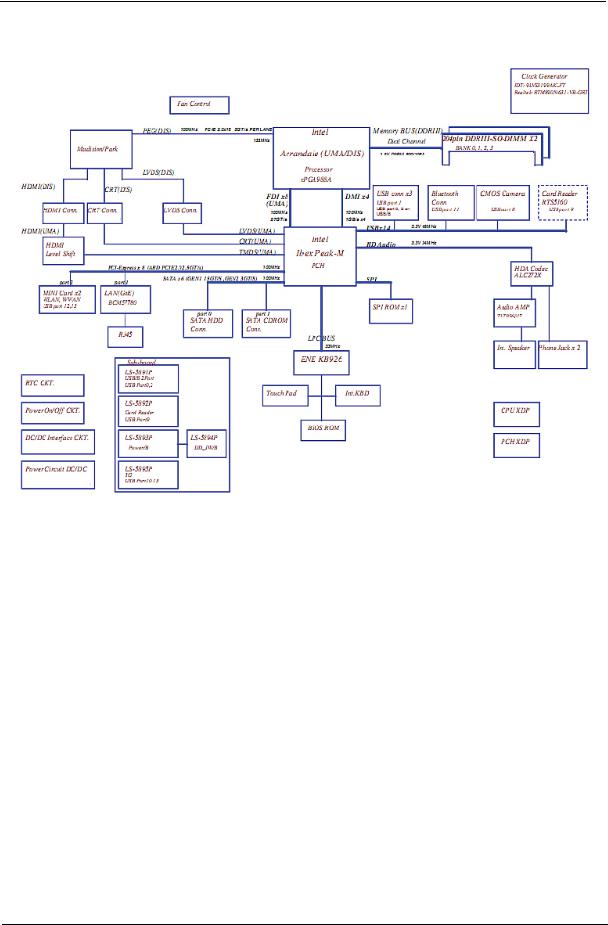
System Block Diagram
Chapter 1 |
5 |

Your Acer Notebook tour
Front View
1
11
2
3
4
10
|
5 |
|
|
|
|
|
|
|
|
|
|
6 |
|
|
|
|
|
|
|
|
9 |
|
|
|
|
|
|
|
|
|
||
|
7 |
|
|
|
|
|
|
|
|
8 |
|
|
|
|
|
|
|
|
|
||
|
|
|
|
|
|
|
|
|
||
|
|
|
|
|
|
|
|
|
|
|
|
|
|
|
|
|
|
|
|
|
|
|
|
|
|
|
|
|
|
|
|
|
No. |
Icon |
|
|
Item |
Description |
|||||
|
|
|
|
|
|
|
|
|
|
|
1 |
|
|
|
|
|
|
Acer Crystal Eye |
Web camera for video communication |
||
|
|
|
|
|
|
|
webcam |
(for selected models). |
||
|
|
|
|
|
|
|
|
|
|
|
2 |
|
|
|
|
|
|
Display screen |
Also called Liquid-Crystal Display (LCD), |
||
|
|
|
|
|
|
|
|
|
|
displays computer output. |
|
|
|
|
|
|
|
|
|
|
|
3 |
|
|
|
|
|
|
HDD |
Indicates when the hard disk drive is active. |
||
|
|
|
|
|
|
|
|
|
|
|
|
|
|
|
|
|
|
Communication |
Indicates the computer’s wireless connectivitoy |
||
|
|
|
|
|
|
|
indicator |
device status. |
||
|
|
|
|
|
|
|
|
|
|
|
4 |
|
|
|
|
|
|
Power button |
Turns the computer on and off. |
||
|
|
|
|
|
|
|
|
|
|
|
5 |
|
|
|
|
|
|
Keyboard |
For entering data into your computer. |
||
|
|
|
|
|
|
|
|
|
|
|
6 |
|
|
|
|
|
|
TouchPad |
Touch-sensitive pointing device which functions |
||
|
|
|
|
|
|
|
|
|
|
like a computer mouse. |
|
|
|
|
|
|
|
|
|
|
|
6 |
Chapter 1 |
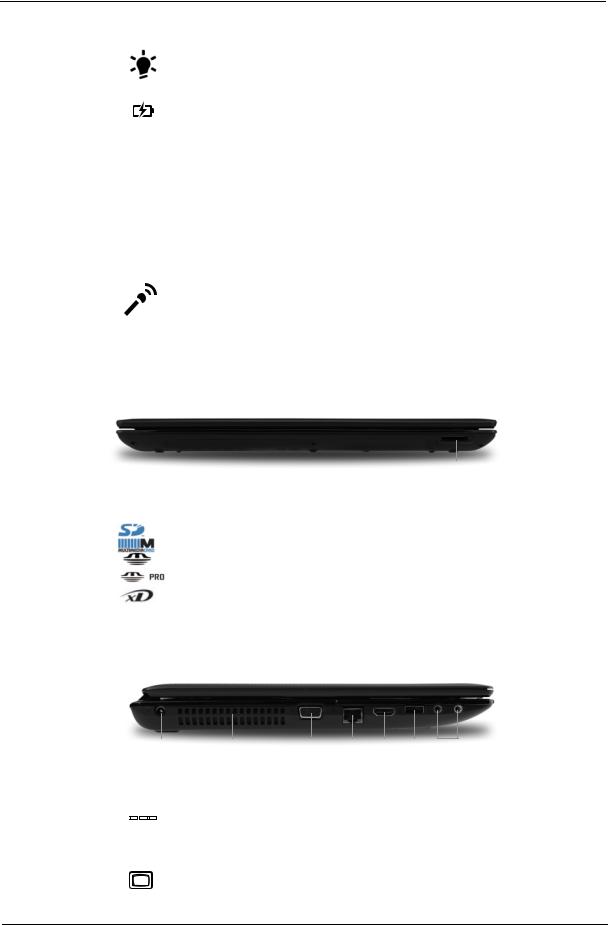
No. |
Icon |
Item |
Description |
|
|
|
|
7 |
|
Power1 |
Indicates the computer’s power status. |
|
|
|
|
|
|
Battery1 |
Indicates the computer’s battery status. |
|
|
|
1. Charging: The light shows amber when the |
|
|
|
battery is charging. |
|
|
|
2. Fully charged: The light shows blue when in |
|
|
|
AC mode. |
8 |
|
Click buttons (left |
The left and right buttons function like the left |
|
|
and right) |
and right mouse buttons. |
|
|
|
|
9 |
|
Palmrest |
Comfortable support area for your hands when |
|
|
|
you use the computer. |
|
|
|
|
10 |
|
Speakers |
Left and right speakers deliver stereo audio |
|
|
|
output. |
11 |
|
Microphone |
Internal microphone for recording sound. |
|
|
|
|
NOTE: 1 The front panel indicators are visible even when the computer cover is closed.
Closed Front View
|
|
|
1 |
|
|
|
|
No. |
Icon |
Item |
Description |
|
|
|
|
1 |
|
Multi-in-1 card |
Accepts Secure Digital (SD), MultiMediaCard |
|
|
reader |
(MMC), Memory Stick (MS), Memory Stick |
|
|
|
PRO (MS PRO), xDPicture Card (xD). |
|
|
|
NOTE: Push to remove/install the card. |
|
|
|
Only one card can operate at any |
|
|
|
given time. |
|
|
|
|
Left View
|
1 |
2 |
3 |
4 |
5 |
6 |
7 |
||||||
|
|
|
|
|
|
|
|
|
|
|
|
|
|
No. |
Icon |
Item |
|
|
|
Description |
|||||||
|
|
|
|
|
|
|
|
|
|
||||
1 |
|
|
|
|
|
|
|
DC-in jack |
Connects to an AC adapter |
||||
|
|
|
|
|
|
|
|||||||
|
|
|
|
|
|
|
|||||||
|
|
|
|
|
|
|
|
|
|
|
|
|
|
2 |
|
|
|
|
|
|
|
Ventilation slots |
Enable the computer to stay cool, even after |
||||
|
|
|
|
|
|
|
|
|
prolonged use. |
|
|
||
3 |
|
|
|
|
|
|
|
External display |
Connects to a display device |
||||
|
|
|
|
|
|
|
|
(VGA) port |
(e.g. external monitor, LCD projector). |
||||
|
|
|
|
|
|
|
|
|
|
|
|
|
|
Chapter 1 |
7 |
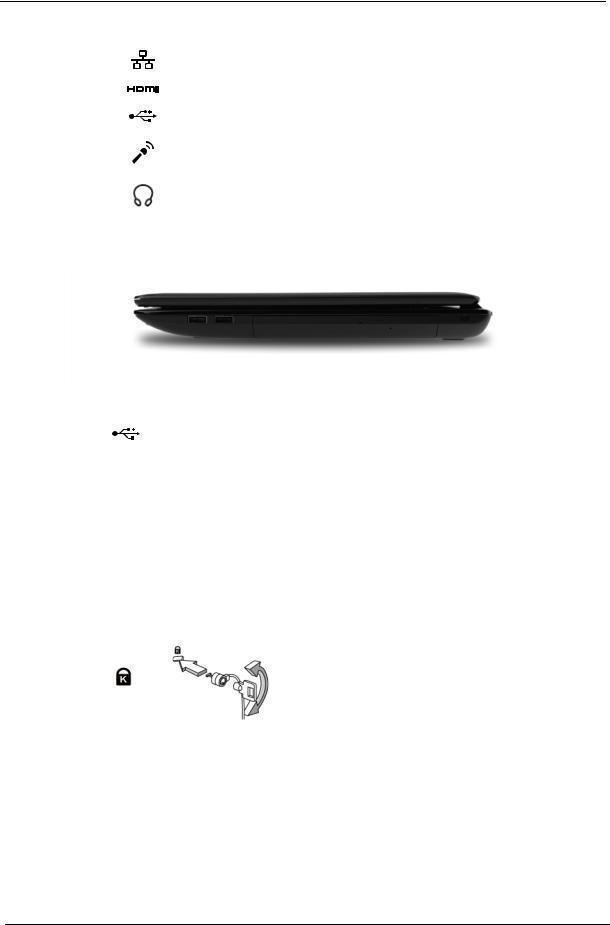
No. |
Icon |
Item |
Description |
|
|
|
|
4 |
|
Ethernet (RJ-45) |
Connects to an Ethernet 10/100/1000-based |
|
|
port |
network. |
|
|
|
|
5 |
|
HDMI |
Connect to HDMI devices |
|
|
|
|
6 |
|
USB 2.0 ports |
Connect to USB 2.0 devices (e.g. USB mouse, |
|
|
|
USB camera). |
|
|
|
|
7 |
|
Microphone-in |
Accepts input from external microphones. |
|
|
jack |
|
|
|
|
|
|
|
Headphones/ |
Connects to audio line-out devices |
|
|
speaker/line-out |
(e.g. speakers, headphones). |
|
|
jack |
|
|
|
|
|
Right View
|
|
|
|
|
|
|
|
|
|
|
|
|
|
|
|
|
|
|
|
|
|
|
|
|
|
|
|
1 |
|
2 |
3 4 5 |
6 |
||||||
|
|
|
|
|
|
|
|
|
|
|
|
|
No. |
Icon |
|
Item |
|
|
|
|
|
|
Description |
||
|
|
|
|
|
|
|
|
|
|
|
|
|
1 |
|
USB 2.0 ports |
|
|
Connect to USB 2.0 devices (e.g. USB mouse, USB |
|||||||
|
|
|
|
|
|
|
camera). |
|
|
|||
|
|
|
|
|
|
|
|
|
|
|
|
|
2 |
|
Optical drive |
|
|
Internal optical drive; accepts CDs or DVDs. |
|||||||
|
|
|
|
|
|
|
|
|
|
|
|
|
3 |
|
Optical disk access |
|
|
Lights up when the optical drive is active. |
|||||||
|
|
indicator |
|
|
|
|
|
|
|
|
||
4 |
|
Optical drive eject |
|
|
Ejects the optical disk from the drive. |
|||||||
|
|
button |
|
|
|
|
|
|
|
|
||
|
|
|
|
|
|
|
|
|
|
|
|
|
5 |
|
Emergency eject hole |
|
|
Ejects the optical drive tray when the computer is |
|||||||
|
|
|
|
|
|
|
turned off. |
|
|
|||
|
|
|
|
|
|
|
Note: Insert a paper clip into the emergency eject |
|||||
|
|
|
|
|
|
|
hole to eject the optical drive tray when the computer |
|||||
|
|
|
|
|
|
|
is off. |
|
|
|||
6 |
|
Kensington lock slot |
|
|
Connects to a Kensington-compatible computer |
|||||||
|
|
|
|
|
|
|
security lock. |
|
|
|||
|
|
|
|
|
|
|
Note: Wrap the computer security lock cable around |
|||||
|
|
|
|
|
|
|
an immovable object such as a table or handle of a |
|||||
|
|
|
|
|
|
|
locked drawer. Insert the lock into the notch and turn |
|||||
|
|
|
|
|
|
|
the key to secure the lock. Some keyless models are |
|||||
|
|
|
|
|
|
|
also available. |
|
|
|||
|
|
|
|
|
|
|
|
|
|
|
|
|
8 |
Chapter 1 |
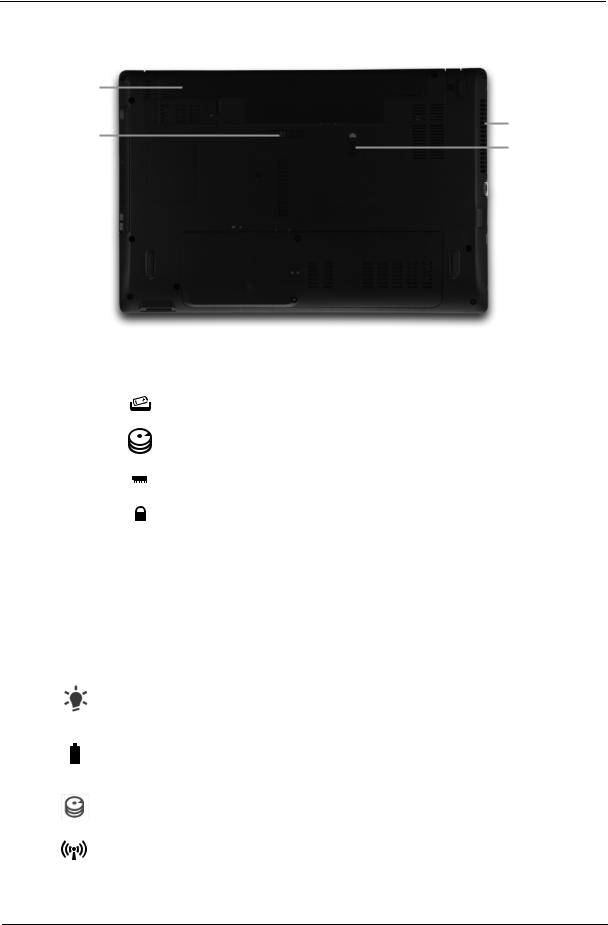
Bottom View
1
2
6
5
3 |
|
|
|
4 |
|
|
|||
|
|
|
|
No. |
Icon |
Item |
Description |
|
|
|
|
1 |
|
Battery bay |
Houses the computer's battery pack. |
|
|
|
|
2 |
|
Battery release |
Releases the battery for removal. |
|
|
latch |
|
|
|
|
|
3 |
|
Hard disk bay |
Houses the computer's hard disk (secured |
|
|
|
with screws). |
|
|
|
|
4 |
|
Memory |
Houses the computer's main memory. |
|
|
compartment |
|
|
|
|
|
5 |
|
Battery lock |
Locks the battery in position. |
|
|
|
|
6 |
|
Ventilation slots |
Enable the computer to stay cool, even after |
|
|
and cooling fan |
prolonged use. |
|
|
|
Note: Do not cover or obstruct the fan opening. |
|
|
|
|
Indicators
The computer has several easy-to-read status indicators.
Icon |
Function |
Description |
||
|
|
|
|
|
|
|
|
Power |
Indicates the computer's power status. |
|
|
|
|
|
|
|
|
Battery |
Indicates the computer's battery status. |
|
|
|
|
NOTE: 1. Charging: The light shows amber when |
|
|
|
|
|
|
|
|
|
the battery is charging. 2. Fully charged: The light |
|
|
|
|
|
|
|
|
|
shows green when in AC mode. |
|
|
|
|
|
|
|
|
HDD |
Indicates when the hard disk drive is active. |
|
|
|
|
|
|
|
|
Communication indicator |
Indicates the computer’s wireless connectivitoy |
|
|
|
|
device status. |
|
|
|
|
|
Chapter 1 |
9 |
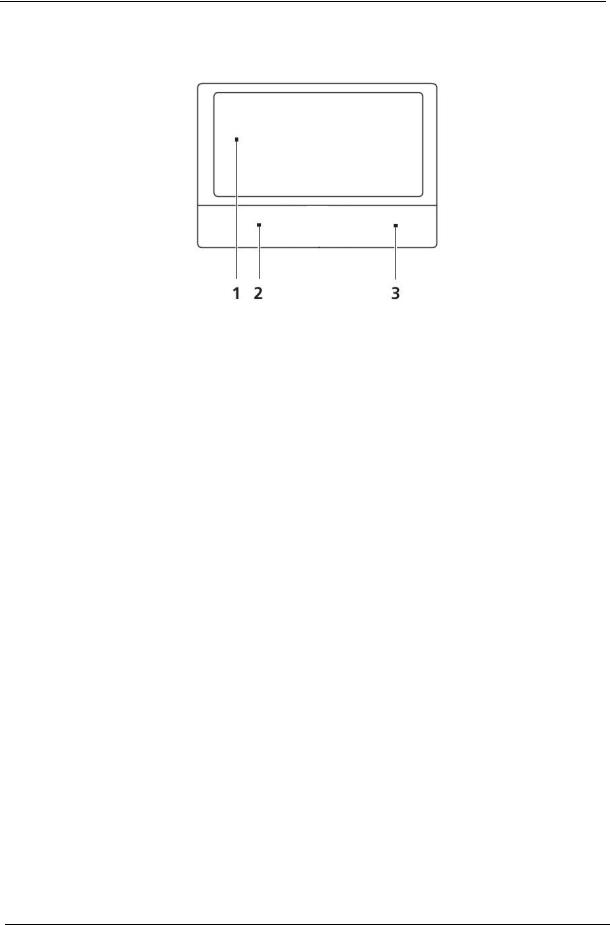
TouchPad Basics
The following items show you how to use the TouchPad:
•Move your finger across the TouchPad (1) to move the cursor.
•Press the left (2) and right (3) buttons located beneath the TouchPad to perform selection and execution functions. These two buttons are similar to the left and right buttons on a mouse. Tapping on the TouchPad is the same as clicking the left button.
Function |
Left Button (2) |
Right Button (3) |
Main TouchPad (1) |
|
|
|
|
Execute |
Quickly click twice. |
|
Tap twice (at the same speed |
|
|
|
as double-clicking a mouse |
|
|
|
button). |
|
|
|
|
Select |
Click once. |
|
Tap once. |
|
|
|
|
Drag |
Click and hold, then use |
|
Tap twice (at the same speed |
|
finger on the TouchPad to |
|
as double-clicking a mouse |
|
drag the cursor. |
|
button); rest your finger on |
|
|
|
the TouchPad on the second |
|
|
|
tap and drag the cursor. |
|
|
|
|
Access |
|
Click once. |
|
context menu |
|
|
|
|
|
|
|
NOTE: When using the TouchPad, keep it - and your fingers - dry and clean. The TouchPad is sensitive to finger movement; hence, the lighter the touch, the better the response. Tapping too hard will not increase the TouchPad’s responsiveness.
10 |
Chapter 1 |
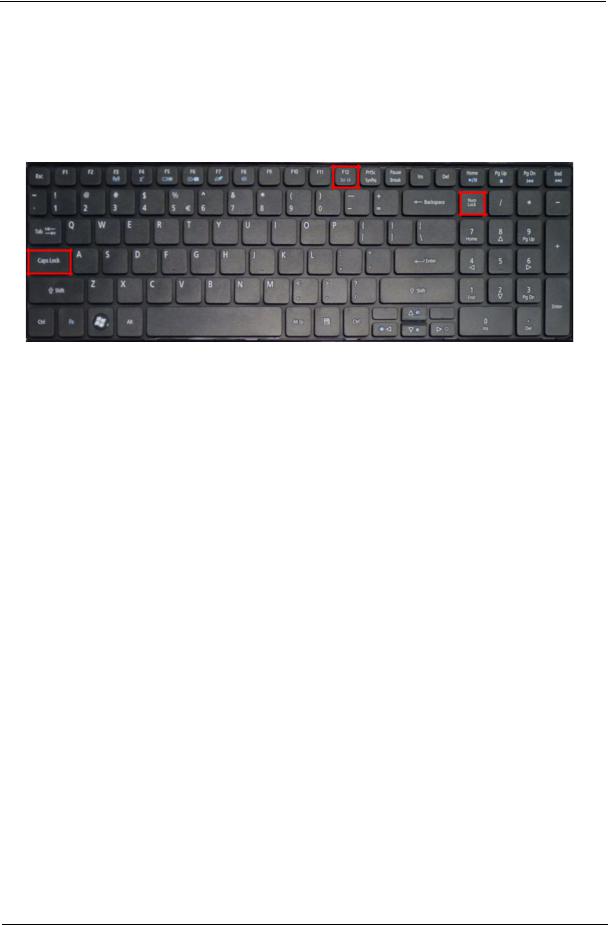
Using the Keyboard
The keyboard has full-sized keys and an embedded numeric keypad, separate cursor, lock, Windows, function and special keys.
Lock Keys and embedded numeric keypad
The keyboard has two lock keys which you can toggle on and off.
Lock key |
Description |
|
|
Caps Lock |
When Caps Lock is on, all alphabetic characters typed are in uppercase. |
|
|
Scroll Lock |
When Scroll Lock is on, the contents of a text window scroll without moving the |
|
cursor. |
Num Lock |
When Num Lock is on, the embedded keypad is in numeric mode. |
|
|
Chapter 1 |
11 |

Windows Keys
The keyboard has two keys that perform Windows-specific functions.
|
|
|
Key |
Description |
|
|
|
|
|
|
|
|
Windows key |
Pressed alone, this key has the same effect as clicking on the Windows Start button; |
|
|
|
|
it launches the Start menu. It can also be used with other keys to provide a variety of |
|
|
|
|
functions: |
|
|
|
|
< >: Open or close the Start menu |
|
|
|
|
< > + <D>: Display the desktop |
|
|
|
|
< > + <E>: Open Windows Explore |
|
|
|
|
< > + <F>: Search for a file or folder |
|
|
|
|
< > + <G>: Cycle through Sidebar gadgets |
|
|
|
|
< > + <L>: Lock your computer (if you are connected to a network domain), or |
|
|
|
|
switch users (if you're not connected to a network domain) |
|
|
|
|
< > + <M>: Minimizes all windows |
|
|
|
|
< > + <R>: Open the Run dialog box |
|
|
|
|
< > + <T>: Cycle through programs on the taskbar |
|
|
|
|
< > + <U>: Open Ease of Access Center |
|
|
|
|
< > + <X>: Open Windows Mobility Center |
|
|
|
|
< > + <BREAK>: Display the System Properties dialog box |
|
|
|
|
< > + <SHIFT+M>: Restore minimized windows to the desktop |
|
|
|
|
< > + <TAB>: Cycle through programs on the taskbar by using Windows Flip 3-D |
|
|
|
|
< > + <SPACEBAR>: Bring all gadgets to the front and select Windows Sidebar |
|
|
|
|
<CTRL> + < > + <F>: Search for computers (if you are on a network) |
|
|
|
|
<CTRL> + < > + <TAB>: Use the arrow keys to cycle through programs on the |
|
|
|
|
taskbar by using Windows Flip 3-D |
|
|
|
|
Note: Depending on your edition of Windows 7, some shortcuts may not function as |
|
|
|
|
described. |
|
|
|
Application |
This key has the same effect as clicking the right mouse button; it opens the |
|
|
|
||
|
|
|
key |
application's context menu. |
|
|
|
||
|
|
|
|
|
12 |
Chapter 1 |
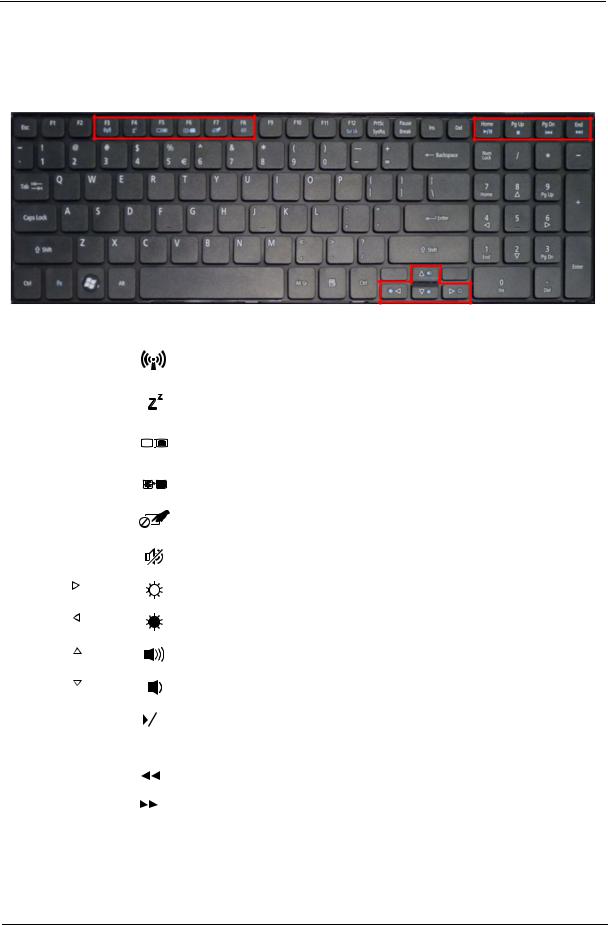
Hot Keys
The computer employs hotkeys or key combinations to access most of the computer’s controls like screen brightness, volume output and the BIOS utility.
To activate hot keys, press and hold the <Fn> key before pressing the other key in the hotkey combination.
Hotkey |
|
Icon |
Function |
Description |
|||||
|
|
|
|
|
|
|
|
|
|
<Fn> + <F3> |
|
|
|
|
|
|
Communication key |
Enables / disables the computer's |
|
|
|
|
|
|
|
|
|
|
communication devices. (Communication |
|
|
|
|
|
|
|
|
|
devices may vary by configuration.) |
|
|
|
|
|
|
|
|
|
|
<Fn> + <F4> |
|
|
|
|
|
|
Sleep |
Puts the computer in Sleep mode. |
|
|
|
|
|
|
|
|
|
|
|
<Fn> + <F5> |
|
|
|
|
|
|
Display toggle |
Switches display output between the display |
|
|
|
|
|
|
|
|
|
|
screen, external monitor (if connected) and |
|
|
|
|
|
|
|
|
|
|
|
|
|
|
|
|
|
|
|
both. |
|
|
|
|
|
|
|
|
|
|
<Fn> + <F6> |
|
|
|
|
|
|
Display Off |
Turns the display screen backlight off to save |
|
|
|
|
|
|
|
|
|
|
power. Press any key to return. |
|
|
|
|
|
|
|
|
|
|
<Fn> + <F7> |
|
|
|
|
|
|
Touchpad toggle |
Turns the internal touchpad on and off. |
|
|
|
|
|
|
|
|
|
|
|
<Fn> + <F8> |
|
|
|
|
|
|
Speaker toggle |
Turns the speakers on and off. |
|
|
|
|
|
|
|
|
|
|
|
<Fn> + < |
> |
|
|
|
|
|
|
Brightness up |
Increases the screen brightness. |
|
|
|
|
|
|
|
|
|
|
<Fn> + < |
> |
|
|
|
|
|
|
Brightness down |
Decreases the screen brightness. |
|
|
|
|
|
|
|
|
|
|
<Fn> + < |
> |
|
|
|
|
|
|
Volume up |
Increases the sound volume. |
|
|
|
|
|
|
|
|
|
|
<Fn> + < |
> |
|
|
|
|
|
|
Volume down |
Decreases the sound volume. |
|
|
|
|
|
|
|
|
|
|
<Fn> + <Home> |
|
|
|
|
|
|
Play/Pause |
Play or pause a selected media file. |
|
|
|
|
|
|
|
||||
|
|
|
|
|
|
|
|
|
|
<Fn> + <Pg Up> |
|
|
|
|
|
|
Stop |
Stop playing the selected media file. |
|
|
|
|
|
|
|
||||
|
|
|
|
|
|
|
|
|
|
<Fn> + <Pg Dn> |
|
|
|
|
|
|
Previous |
Return to the previous media file. |
|
|
|
|
|
|
|
||||
|
|
|
|
|
|
|
|
|
|
<Fn> + <End> |
|
|
|
|
|
|
Next |
Jump to the next media file. |
|
|
|
|
|
|
|
||||
|
|
|
|
|
|
|
|
|
|
Chapter 1 |
13 |

Hardware Specifications and Configurations
Item |
|
|
|
|
|
|
Specification |
|
|
|
|
|
|
|
|
|
|
|
|
|
|
|
|
CPU |
|
|
Intel Mobile Calpella |
|
|
|
|
|
|||
|
|
|
|
|
|
|
|
|
|
|
|
Graphics |
|
|
Integrated VGA for Arrandale |
|
|
|
|
||||
|
|
|
|
|
|
|
|
|
|
|
|
CPU Package |
|
|
rPGA988A |
|
|
|
|
|
|||
|
|
|
|
|
|
|
|
|
|
|
|
Power |
|
|
4M (Arrandale) L3 shared among all cores |
|
|
|
|||||
|
|
|
|
|
|
|
|
|
|
|
|
On-die Cache |
|
|
32KB L1 & 256K L2 for each core |
|
|
|
|||||
|
|
|
|
|
|
|
|
|
|
|
|
Processor Specifications |
|
|
|
|
|
|
|
|
|||
|
|
|
|
|
|
|
|
|
|
|
|
Item |
|
CPU |
|
Core |
Bus |
|
Cache |
Package |
Core |
Acer P/N |
|
|
Speed |
|
s |
Speed |
|
Size |
Voltage |
|
|||
|
|
|
|
|
|
|
|||||
|
|
|
|
|
|
|
|
|
|
|
|
Ci3330M |
|
2.13 |
|
2 |
330 M |
|
3 MB |
PGA988 |
35W |
KC.33001.DMP |
|
|
|
|
|
|
|
|
|
|
|
|
|
Ci3350M |
|
2.26 |
|
2 |
350 M |
|
3 MB |
PGA988 |
35W |
KC.35001.DMP |
|
|
|
|
|
|
|
|
|
|
|
|
|
Ci5430M |
|
2.26 |
|
2 |
430 M |
|
3 MB |
PGA988 |
35W |
KC.43001.DMP |
|
|
|
|
|
|
|
|
|
|
|
|
|
Ci5520M |
|
2.24 |
|
2 |
520 M |
|
3 MB |
PGA988P |
35W |
KC.52001.DMP |
|
|
|
|
|
|
|
|
|
|
|
|
|
Ci5540M |
|
2.53 |
|
2 |
540 M |
|
3 MB |
PGA988 |
35W |
KC.54001.DMP |
|
|
|
|
|
|
|
|
|
|
|
|
|
Ci7620M |
|
2.66 |
|
2 |
620 M |
|
4 MB |
PGA988P |
35W |
KC.62001.DMP |
|
|
|
|
|
|
|
|
|
|
|
|
|
CPU Fan True Value Table (Tj = 90)
CPU Temp (°C) |
|
CPU Temp (°C) |
Fan Speed (rpm) |
SPL Spec (dBA) |
Core 0 |
|
Core 1 |
||
|
|
|
||
|
|
|
|
|
45 |
57 |
|
2300 |
28 |
52 |
64 |
|
3000 |
31 |
|
|
|
|
|
59 |
70 |
|
3100 |
34 |
|
|
|
|
|
65 |
78 |
|
3500 |
37 |
|
|
|
|
|
72 |
85 |
|
3900 |
40 |
|
|
|
|
|
•Throttling 50%: On=85°C, Off=72°C
•OS Shutdown: 104°C
•H/W Shutdown: 92°C
CPU Fan True Value Table (Tj = 105)
CPU Temp (°C) |
CPU Temp (°C) |
Fan Speed (rpm) |
SPL Spec (dBA) |
|
Core 0 |
Core 1 |
|||
|
|
|||
|
|
|
|
|
45 |
60 |
2300 |
28 |
|
|
|
|
|
|
55 |
70 |
3000 |
31 |
|
|
|
|
|
|
65 |
80 |
3100 |
34 |
|
|
|
|
|
|
75 |
90 |
3500 |
37 |
|
|
|
|
|
|
85 |
100 |
3900 |
40 |
|
|
|
|
|
•Throttling 50%: On=100°C, Off=85°C
•OS Shutdown: 104°C
•H/W Shutdown: 92°C
14 |
Chapter 1 |

Fan Acoustic Specifications
Operation |
Application |
SPL |
Loudness (Sone) |
Tone (dB) |
|
Mode |
dBA |
||||
|
|
|
|||
|
|
|
|
|
|
Fan off |
Windows Idle (HDD random |
N/A |
• 20~3.99kHz less than or |
7 |
|
|
seek) |
|
equal to: 0.5 |
|
|
|
|
|
• 4K~20kHz less than or |
|
|
|
|
|
equal to: 0.035 |
|
|
|
|
|
|
|
|
Fan 1 |
Windows Idle |
28 |
N/A |
7 |
|
|
|
|
|
|
|
Fan 2 |
Windows Idle, HDD spinning |
31 |
N/A |
7 |
|
|
|
|
|
|
|
Fan 3 |
Play Movie (read from HDD), |
34 |
N/A |
7 |
|
|
Play TV (TV tuner sku) |
|
|
|
|
|
|
|
|
|
|
Fan 4 |
3DMark06,Prime95, |
37 |
N/A |
7 |
|
|
Prime95+Play TV(TV tuner |
|
|
|
|
|
sku), acer screen saver, HDD |
|
|
|
|
|
spinning |
|
|
|
|
|
|
|
|
|
|
Fan 5 |
TAT100% or |
40 |
N/A |
7 |
|
|
Thermanow100%,3DMark06, |
|
|
|
|
|
at ambient 35C, HDD |
|
|
|
|
|
spinning |
|
|
|
|
|
|
|
|
|
NOTE: Tone:20~399Hz refer to slope of Ecma-074, 400~20K Hz < 7 Prominence ratio,No pattern occurred on Prominence vs. time diagram
BIOS
Item |
|
Specification |
|
|
|
BIOS vendor |
Insyde BIOS |
|
|
|
|
BIOS ROM type |
Flash |
|
|
|
|
Features |
• |
Flash ROM 4MB |
|
• |
Support ISIPP |
|
• |
Support Acer UI |
|
• Support multi-boot |
|
|
• Suspend to RAM (S3)/Disk (S4) |
|
|
• Various hot-keys for system control |
|
|
• Support SMBIOS 2.3, PCI2.2. |
|
|
• Refer to Acer BIOS specification. |
|
|
• DMI utility for BIOS serial number configurable/asset tag |
|
|
• |
Support PXE |
|
• |
Support Y2K solution |
|
• |
Support WinFlash |
|
• Wake on LAN from S3 |
|
|
• Wake on LAN form S4 in AC mode |
|
|
• |
System information |
|
|
|
System Memory |
|
|
|
|
|
Item |
|
Specification |
|
|
|
Memory size |
8GB maximum |
|
|
|
|
DIMM socket number |
2 |
|
|
|
|
Supports memory size per socket |
4GB |
|
|
|
|
Supports DIMM type |
204-pin +1.5V DDRIII |
|
|
|
|
Supports DIMM Speed |
800/1066 MHz |
|
|
|
|
Chapter 1 |
15 |

Item |
|
Specification |
|
|
|
|
|
Supports DIMM voltage |
1.5V |
|
|
Memory Combinations |
|
|
|
|
|
|
|
Slot 1 |
Slot 2 |
|
Total Memory |
|
|
|
|
0MB |
1024MB |
|
1024MB |
0MB |
2048MB |
|
2048MB |
|
|
|
|
0MB |
4096MB |
|
4096MB |
|
|
|
|
1024MB |
0MB |
|
1024MB |
|
|
|
|
1024MB |
1024MB |
|
2048MB |
|
|
|
|
1024MB |
2048MB |
|
3072MB |
|
|
|
|
2048MB |
0MB |
|
2048MB |
|
|
|
|
2048MB |
1024MB |
|
3072MB |
|
|
|
|
2048MB |
2048MB |
|
4096MB |
|
|
|
|
2048MB |
4096MB |
|
6144MB |
|
|
|
|
4096MB |
4096MB |
|
8192MB |
|
|
|
|
NOTE: Above table lists some system memory configurations. You may combine DIMMs with various capacities to form other combinations. In the above table, the configuration of slot 1 and slot 2 could be reversed.
Onboard LAN
|
Item |
|
Specification |
|
|
|
|
Manufacturer |
|
Broadcom 57780KMLG for GIGA LAN |
|
|
|
• |
Integrated 10/100/10000BASE-T transceiver |
|
|
• Automatic MDI crossover function |
|
|
|
• |
PCIe V1.1 compliant |
|
|
• |
10/100/10000BASE-T full -duplex/half -duplex MAC |
|
|
• Receive side scaling(RSS) for multicore processors |
|
|
|
• Complies with IEEE 802.3, 802.3u, 802.3ab, and |
|
|
|
|
802.1p |
|
|
• Wake on LAN (WOL) support meeting the ACPI |
|
|
|
|
requirements |
|
|
• Statistics for SNMP MIB II, Ethernet-like MIB, and |
|
|
|
|
Ethernet MIB (IEEE 802.3z, Clause 30) |
|
|
• Self-boot feature, utilizing smaller EEPROM size with |
|
|
|
|
ability to use on-chip memory |
|
|
• |
Supports iSCSI boott |
|
|
• PCI Express CLKREQ support |
|
|
|
• Integrated switching regulator for improved power |
|
|
|
|
consumption |
|
|
• IPv4 and IPv6 large send offload and checksum |
|
|
|
|
offload(LSO/TCO) |
|
|
|
|
16 |
Chapter 1 |

Hard Disk Drive Interface
|
Item |
|
|
|
Specification |
|
|
|
||
|
|
|
|
|
|
|
|
|
|
|
|
Vendor & Model |
Seagate |
|
HGST |
Toshiba |
Western Digital |
|
|||
|
Name |
|
|
|
|
|
|
|
|
|
|
|
|
|
|
|
|
|
|
|
|
|
Capacity (MB) |
160, 250, 320, |
|
160, 250, |
160, 250, |
160, 250, 320, |
|
|||
|
|
|
|
500 |
|
320, 500 |
320, 500 |
500, 640 |
|
|
|
|
|
|
|
|
|
|
|
|
|
|
Bytes per sector |
|
512 |
|
|
|
||||
|
|
|
|
|
|
|
|
|
|
|
|
Data heads |
|
|
2-4 |
|
|
|
|||
|
|
|
|
|
|
|
|
|
|
|
|
Drive Format |
|
|
|
|
|
|
|
|
|
|
|
|
|
|
|
|
|
|
|
|
|
Disks |
|
|
1-2 |
|
|
|
|||
|
|
|
|
|
|
|
|
|
||
|
Spindle speed |
|
5400 |
|
|
|
||||
|
(RPM) |
|
|
|
|
|
|
|
|
|
|
|
|
|
|
|
|
|
|
|
|
|
Performance Specifications |
|
|
|
|
|
|
|||
|
|
|
|
|
|
|
|
|
|
|
|
Buffer size |
|
|
|
8 MB |
|
|
|
||
|
|
|
|
|
|
|
|
|
|
|
|
Interface |
|
|
|
SATA |
|
|
|
||
|
|
|
|
|
|
|
|
|
|
|
|
DC Power Requirements |
|
|
|
|
|
|
|||
|
|
|
|
|
|
|
|
|
|
|
|
Voltage |
|
5V ±5% |
|
5V ±5% |
5V ±5% |
5V ±5% |
|
||
|
tolerance |
|
|
|
|
|
|
|
|
|
|
|
|
|
|
|
|
|
|
|
|
Super-Multi Drive Module |
|
|
|
|
|
|
||||
|
|
|
|
|
|
|
|
|
|
|
Item |
|
|
|
|
Specification |
|
|
|
||
|
|
|
|
|
|
|
|
|
||
Vendor & model |
|
HLDS GT20N |
|
|
Sony AD7580S |
|
|
|
||
name |
|
|
|
|
|
|
|
|
|
|
|
|
|
|
|
|
|
||||
Performance |
|
With CD Diskette |
With DVD Diskette |
With CD Diskette |
|
With DVD Diskette |
||||
Specification |
|
|
|
|
|
|
|
|
|
|
|
|
|
|
|
|
|
||||
Transfer rate (MB/ |
|
Sustained: |
Sustained: |
Sustained: |
|
Sustained: |
||||
sec) |
|
3,600 KB/s (24x) |
11.08 Mbytes/s |
1,571 (typical) |
|
10,993 (typical) |
||||
|
|
|
max. |
|
(8x) max. |
|
|
|
|
|
|
|
|
|
|
|
|
|
|
|
|
Buffer Memory |
|
2 MB |
|
|
|
|
|
|
|
|
|
|
|
|
|
|
|
|
|
|
|
Interface |
|
SATA |
|
|
|
|
|
|
|
|
|
|
|
|
|
|
|
|
|
|
|
Chapter 1 |
17 |

|
Item |
|
|
Specification |
||
|
|
|
|
|
|
|
Applicable disc |
DVD-ROM: |
|
DVD Read: |
|||
formats |
4.7GB |
(Single Layer) |
DVD-ROM (DVD-5, DVD-9, DVD-10, DVD- |
|||
|
|
8.5GB |
(Dual Layer) |
18), DVD-Video, DVD-Audio, SACD (Hybrid), |
||
|
|
DVD-R: |
|
|
UDF DVD, DVD-R, DVD-R DL, DVD-R 3.95 |
|
|
|
3.95GB (Ver. 1.0: read only) |
GB, DVD-R Authoring, DVD-R Multi-Border, |
|||
|
|
DVD-RW, DVD+R, DVD+R DL, DVD+R |
||||
|
|
4.7GB (Ver. 2.0 for Authoring: read only) |
||||
|
|
Multi-Session, DVD+RW, DVD-RAM V1.0, |
||||
|
|
4.7GB (Ver. 2.1 for General: read & write) |
||||
|
|
DVDRAM |
||||
|
|
(DL) 8.5GB |
(Ver. 3.0) |
V2.0 & 2.1 &2.2. |
||
|
|
DVD-RW: |
|
|||
|
|
|
|
|
||
|
|
4.7GB (Ver. 1.2/ Rev 1.0, 2.0, 3.0) |
CD Read: |
|||
|
|
DVD-RAM: 1.46GB/side, 4.7GB/side |
||||
|
|
CD-DA, CD-ROM Mode-1, CD-ROM/XA |
||||
|
|
(Ver. 2.2) |
|
|||
|
|
|
Mode-2 Form-1 and Mode-2 Form-2, CD-i, |
|||
|
|
DVD+R: 4.7GB (Ver. 1.3) |
||||
|
|
CD-i |
||||
|
|
(DL) 8.5GB |
(Ver. 1.1) |
|||
|
|
Bridge, Video-CD (MPEG-1), Karaoke CD, |
||||
|
|
DVD+RW: |
|
|||
|
|
|
Photo-CD, Enhanced CD, CD Plus, CD |
|||
|
|
4.7GB (Vol.1 Ver.1.3) |
Extra, itrax |
|||
|
|
|
|
|
CD, CD-Text, UDF CD, CD-R, and CD-RW |
|
|
|
CD-ROM Mode-1 data disc |
|
|
||
|
|
CD-ROM Mode-2 data disc |
DVD Write: |
|||
|
|
CD-ROM XA, CD-I, Photo-CD Multi- |
DVD Data & Video |
|||
|
|
Session, Video CD |
|
|
||
|
|
CD-Audio Disc |
CD Read: |
|||
|
|
Mixed mode CD-ROM disc (data and |
CD-DA, CD-ROM Mode-1, CD-ROM/XA |
|||
|
|
audio) |
|
|
Mode-2 Form-1 and Mode-2 Form-2, CD-i, |
|
|
|
CD-Extra |
|
Video- |
||
|
|
CD-Text |
|
|
CD, CD-Text |
|
|
|
CD-R (Conforming to “Orange Book Part |
|
|
||
|
|
2”: read & write) |
|
|
||
|
|
CD-RW (Conforming to “Orange Book |
|
|
||
|
|
Part 3”: read & write) |
|
|
||
|
|
|
|
|
|
|
Loading mechanism |
Drawer (Solenoid Open) |
|
|
|||
|
|
Tact SW (Open) |
|
|
||
|
|
Emergency Release (draw open hole) |
|
|
||
|
|
|
|
|
|
|
Power Requirement |
|
|
|
|
|
|
|
|
|
|
|
|
|
Input Voltage |
|
|
DC 5 V +/- 5% |
|||
|
|
|
|
|
|
|
|
Audio Interface |
|
|
|
|
|
|
|
|
|
|
|
|
|
Item |
|
|
Specification |
|
|
|
|
|
|
|
|
|
|
Chipset |
|
Realtek ALC272-X |
|
|
|
|
|
|
|
|
|
|
|
Features |
|
• |
High Definition Audio Codec |
|
|
|
|
|
• |
Single Analogue MIC |
|
|
|
|
|
• 2.0 Watt speaker/5cc chamber/speaker size 18 phi, x2 |
|
||
|
|
|
• Headphone-out w/o SPDIF-out |
|
||
|
|
|
|
|
|
|
|
Power and Keyboard Controller |
|
|
|||
|
|
|
|
|
|
|
|
Item |
|
|
|
Specification |
|
|
|
|
|
|
|
|
|
Controller |
|
|
ENE KB926 |
|
|
|
Total number of keypads |
|
99-/100-/103-key keyboard |
|
|
|
|
|
|
|
|
|
|
|
Windows logo key |
|
|
Yes |
|
|
|
|
|
|
|
|
|
|
Hotkeys |
|
|
See “Hot Keys” on page 13. |
|
|
|
|
|
|
|
|
|
18 |
Chapter 1 |

Battery
Item |
Specification |
|
6 Cell |
||
|
||
|
|
|
Vendor & model name |
SANYO/SONY/PANASONIC/SAMSUNG/SIMPLO AS2009A |
|
Battery Type |
Li-ion |
|
|
|
|
Pack capacity |
4400 mAh |
|
|
|
|
Normal Voltage |
2.2 Ah |
|
|
|
|
Package configuration |
3S2P |
|
|
|
Chapter 1 |
19 |

LCD 15.6”
|
Item |
|
Specification |
|
|
|
|
|
|
|
|
|
Vendor/model name |
|
AUO/CPT/CMO/Samsung/LCD/INL |
|
|
|
Screen Diagonal (mm) |
|
15.6 inches |
|
|
|
|
|
|
|
|
|
Display resolution (pixels) |
|
1366 x 768 WXGA Clare |
|
|
|
|
|
|
|
|
|
Pixel Pitch |
|
0.204 x 0.204 |
|
|
|
|
|
|
|
|
|
Display Mode |
|
Normal |
|
|
|
|
|
|
|
|
|
Typical White Luminance (cd/m2) |
|
220 |
|
|
|
(also called Brightness) |
|
|
|
|
|
|
|
|
|
|
|
Contrast Ratio |
|
500 typical |
|
|
|
|
|
|
|
|
|
Response Time (Optical Rise |
|
8 |
|
|
|
Time/Fall Time) msec |
|
|
|
|
|
|
|
|
|
|
|
Luminance Uniformity |
|
1.25 max |
|
|
|
|
|
|
|
|
|
Electrical Interface |
|
LVDS |
|
|
|
|
|
|
|
|
|
Support Color |
|
262K |
|
|
|
|
|
|
|
|
|
Viewing Angle (up/down/right/ |
|
15/35/45/45 |
|
|
|
left) |
|
|
|
|
|
Temperature Range (°C) |
|
0 to +50 |
|
|
|
Operating |
|
-20 to +60 |
|
|
|
Storage (shipping) |
|
|
|
|
|
|
|
|
|
|
|
Card Reader |
|
|
|
|
|
|
|
|
|
|
|
Item |
|
|
Specification |
|
|
|
|
|
|
|
|
Part Name |
|
RealTek RT5160 |
|
|
|
|
|
|
|
|
|
Package |
|
5-in-1 card reader |
|
|
|
|
|
|
|
|
|
General Features |
|
• |
PCI-E interface |
|
|
|
|
• Push-push type |
|
|
|
|
|
• |
Dummy card |
|
|
|
|
|
|
|
20 |
Chapter 1 |
